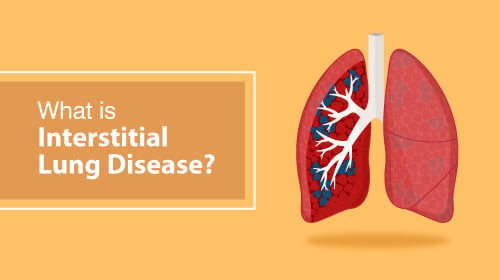Interstitial Lung Disease: Symptoms, Causes, and Types
June 17, 2022

Interstitial lung disease (ILD) is another name for pulmonary fibrosis, a condition characterised by scarring and inflammation of the interstitium. This scar can stiffen lung tissue and cause respiratory distress. ILD may be confined to the lungs or associated with conditions affecting other body parts, such as rheumatoid arthritis and sarcoidosis.
These illnesses share common features, including a dry cough and shortness of breath. Although they may look similar radiographically (on chest X-rays or CT scans of the chest), ILDs of different causes and conditions have different treatments and outlooks. ILD occurs more commonly in adults, but it is rare in children.
Types of Interstitial lung disease (ILD)
ILD has more than 200 underlying causes. ILD is divided into categories based on the causes of its multiple illnesses. These ILDs consist of:
- ILD connected to another medical condition: Some people with autoimmune diseases also have ILD; hence the two conditions are connected (the immune system harms the body). For example, some autoimmune illnesses include rheumatoid arthritis, scleroderma, polymyositis/dermatomyositis, lupus, and sarcoidosis.
- ILD caused by breathing harmful substances: If you breathe in toxic substances, like coal dust, asbestos, tobacco smoke, or hairdressing chemicals, you may develop a lung disease called ILD.
- Genetic ILD: When an illness is passed down through the family, it is referred to as a genetic ILD. These illnesses include Gaucher disease and neurofibromatosis, where tumours develop on nerves (marked by enlargement of internal organs, including the spleen and liver, and bone lesions).
- Idiopathic intracranial leukodystrophy (ILD) is a disease in which the cause is unknown. Idiopathic lung disease is usually found in older people who are above 60 years.
How do the signs of interstitial lung disease look like?
Most ILD sufferers experience symptoms that make breathing challenging, such as:
- Breathing difficulty
- Coughing, usually ineffective
- Reduced capacity for exercise
- Fatigue
- Loss of weight
Symptoms of Interstitial Lung Disease
Breathlessness is the most typical symptom of all interstitial lung diseases. In addition, breathlessness is a common symptom of ILD and can worsen over time.
The following are other signs of interstitial lung disease:
- Coughing rarely produces mucus and is often dry.
- Loss of weight, most frequently in those with COP or BOOP.
- The majority of ILDs cause slow-moving development of breathlessness (over months). If you have acute interstitial pneumonitis (in hours or days), your symptoms will appear fast.
Interstitial Lung Disease Types
The interstitium thickens in all types of interstitial lung disease. This may result from swelling, scarring, or a fluid buildup. Some ILD types are transient (acute), while others are persistent (chronic).
The following are a few forms of interstitial lung disease:
- Pneumonia with interstices: The interstitium can get infected by bacteria, viruses, or fungi. The leading cause is a bacterium called Mycoplasma pneumonia.
- Idiopathic pulmonary fibrosis: The interstitium begins to produce scar tissue. However, experts are uncertain about its underlying cause.
- Nonspecific interstitial pneumonia is a type of pneumonia that is not explicitly related to any one type of bacteria or virus. This lung disease is often found in people with autoimmune conditions such as rheumatoid arthritis or scleroderma.
- Hypersensitivity pneumonitis: This occurs when long-term irritation of your lungs from breathing in dust, mould, or other substances causes.
- Cryptogenic organising pneumonia (COP): COP is an interstitial lung illness that resembles pneumonia but isn’t infectious. Your doctor may diagnose this as organised pneumonia and bronchiolitis obliterans (BOOP).
- Acute interstitial pneumonitis is a lung infection that can be life-threatening. This is a severe lung disease that can suddenly occur. People with lung disease often need to be connected to a machine called a ventilator that helps them breathe.
- Sarcoidosis leads to interstitial lung disease, along with swollen lymph nodes. In addition, it can affect your heart, skin, nerves, and eyes.
- The inhalation of asbestos fibres causes asbestosis. This is an interstitial lung disease caused by breathing in asbestos fibres used in building materials.
Risk Factors
The cause of most interstitial lung diseases is unknown. Bacteria, viruses, and fungi can cause pneumonia, which is a type of lung infection. You may also get ILD if you regularly inhale something that bothers your lungs. These include:
- Asbestos
- Bird proteins (such as those from exotic birds, chickens, or pigeons)
- Coal dust or other various metal specks of dust from mining operations
- Grain dust from agriculture
- Silica dust
- Talc
Diagnosis of Interstitial Lung Disease
Common symptoms of interstitial lung disease include coughing and shortness of breath. To diagnose the issue, your doctor usually does imaging tests on your lungs.
- Chest X-ray For most persons with a respiratory issue, a simple chest X-ray is an initial examination. People with interstitial lung disease may have thin lines in their lungs visible on chest X-rays.
- CT scan produces detailed images of the lungs and surrounding structures by taking many chest X-rays. Usually, these tests can detect interstitial lung disease.
- CT scan with high resolution. Depending on the settings of your CT scan, your interstitium may be more clearly seen if your doctor suspects you have an interstitial lung disease.
- A lung function test is a way to check how well your lungs are. You sit in a sealed plastic booth and breathe through a tube to measure the amount of air you can breathe in and out. If you have ILD, your lung capacity might be reduced. As a result, you might be less able to transfer oxygen from your lungs into your blood.
- High-definition CT scan: With particular CT scan settings, your interstitium can be more clearly seen if your doctor suspects you have an interstitial lung illness. Your doctor can diagnose you with the aid of this.
ILD Complication
Severe interstitial lung disease can lead to serious complications such as high blood pressure in the lungs, respiratory failure, and right-sided heart failure.
People also ask
1. What is the most common cause of interstitial lung disease?
Long-term exposure to hazardous substances like asbestos can result in interstitial lung disease.
2. What is the life expectancy of a person with interstitial lung disease?
The current average lifespan for those with this type is 3 to 5 years. With some medicines and depending on how it progresses, it may last longer. Other interstitial lung diseases, such as sarcoidosis, can cause patients to live significantly longer.
3. What are examples of interstitial lung disease?
- Interstitial pneumonia
- Idiopathic pulmonary fibrosis
- Nonspecific interstitial pneumonitis
- Hypersensitivity pneumonitis
- Cryptogenic organising pneumonia (COP)
- Acute interstitial pneumonitis
- Desquamative interstitial pneumonitis
- Sarcoidosis
4. What are the symptoms of interstitial lung disease?
- Breathlessness, especially during physical activity.
- Cough that is dry and hacking but does not generate phlegm.
- Extreme weakness and fatigue.
- No appetite.
- Loss of weight without cause.
- Mild chest discomfort
- Shallow, maybe rapid, laboured breathing.
- Lungs that are bleeding.








